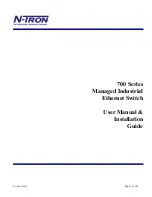
Repeater (Hub) Management
22
The management agent can also take advantage of selected special control
(escape) sequences that the terminal may use for screen control. Table 4 lists
these special sequences:
Table 4:
Optional Terminal Control Sequences
You may configure any or all of these optional sequences. To configure a
commonly used terminal type quickly, you can specify an American National
Standards Institute (ANSI) (DEC VT-100) terminal. The software then “auto
configures” for the VT-100 (or one of the multitude of terminals emulating the
VT-100).
By default, the Omega software treats your terminal as a “dumb” terminal
(incapable of any of the optional sequences in Table 4). In this mode, only the
basic control characters shown in Table 3 on page 21 will be used. The screen
is painted by scrolling upward. To update a screen display, Omega scrolls a
fresh display onto the terminal screen. Although scrolling is used, it is done in
such a way as to make it appear to be a full-screen display—it does not have
the appearance of a line-at-a-time “glass teletype.”
If you configure a terminal with the Erase Screen capability, Omega does not
scroll the screen but instead erases and paints the screen top-down. This is
generally more pleasant than scrolling.
If the terminal has the Home Cursor capability, Omega will not erase or scroll
the screen to update an existing display, but will instead “home” the cursor
and then display updated information. This avoids the appearance of screen
“flicker.”
The Erase End Of Line capability provides an efficient method for the
management agent to erase old information when updating an existing
display. If Erase End Of Line is not configured, Omega will use an
appropriate number of space characters to erase old information.
The terminal screen must be 80 or more characters in width, and either 24 or
25 lines in height. You can configure Omega to echo characters as received
(“full duplex”) or to not echo (“half duplex”). No form of block mode is
supported.
Home Cursor
Moves the cursor to the top-left screen position.
Erase Screen
Erases the entire screen, or erases from the current position to
end-of-screen.
Erase EOL
Erases from the current position to the end of the current line.
















































